
Except for the usual annual disturbances (mainly births, deaths and no marriages), 2024 generally met expectations. We got to do some more overseas travel to (click on the links):
and of course, while in Europe, we went to Berlin, to visit Emily, Guido, Leander and Tilda. We also had another pleasant a stopover in London, with a side trip to Bath.
Back in Australia, the biggest news was another grandchild, Sebastian, to Julia and Sam, who also became property owners.
Meanwhile our other grandchildren, to Wendy's children, Jordan and Heath: Billy and Vivienne and Thomas and Allice, are rapidly approaching high school (Thomas has started) and are steadily amassing various academic, social and sporting accolades. Proud parents.
In these days of cosmopolitan living, much of our family will be widely dispersed over the festive season but we will get together again in 2025.
Those of you who read last year's message may find some of the following familiar.

In February 2022 we were, at last, able to travel interstate to Victoria without and COVID-19 restrictions.
The virus is still active but less deadly and one by one the States are accepting that we now need to live with it.
So, it was off to Melbourne for a 'Luxury Escape'.
According to Google Maps, it's now possible to drive the 900km to Melbourne (down the M31) in nine hours, non-stop. I once did it on older roads in under twelve, changing a flat tyre on the way. But it's no fun. Much better to fly, as we've done in the past.
This time, we decided to drive again but by a longer route (1,160 km each way), stopping twice in each direction overnight. It would be more relaxing and we'd see some unvisited country on the way.
It would be like driving from Berlin to Paris (1,055 km) but with no stop in historic Cologne (where, at age 10, my eldest daughter, Emily, declined to go into the cathedral with me - as she would have to bin her McDonald's milkshake).
Our first stop would be at Kiora near Moruya.
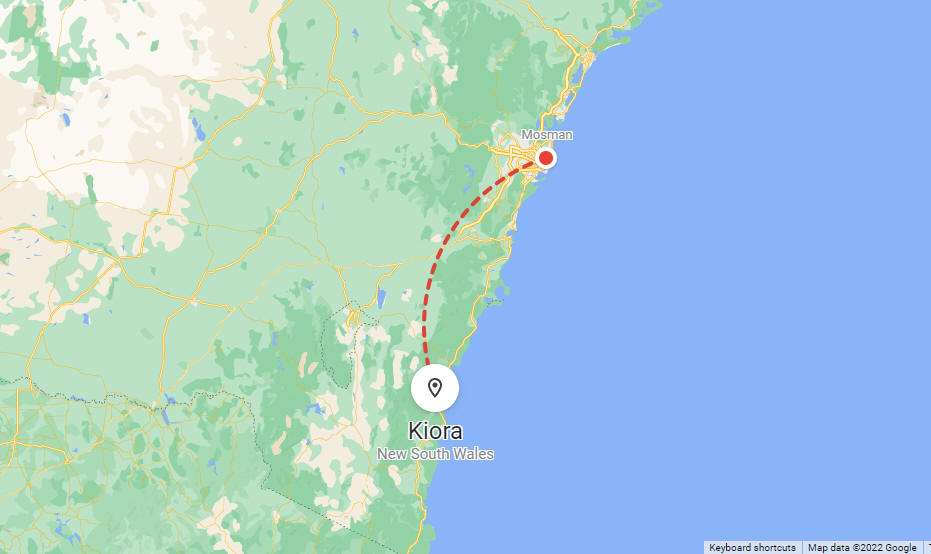
Mosman to Kiora - 320 km - about four and a half hours driving plus a lunch stop
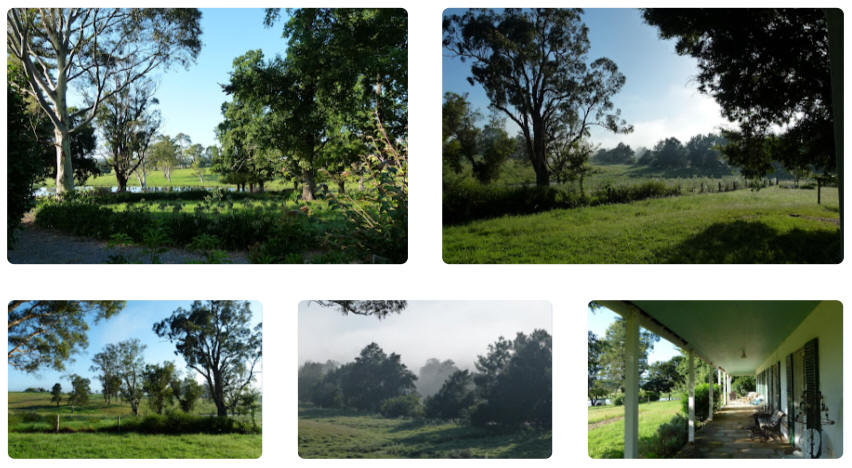
At Kiora we enjoyed very comfortable (and free) accommodation, curtesy of Sally (Julia's mother) who was unable to be there, as she had higher responsibilities elsewhere.
A neighbour's cow-herd had invaded her garden and I undertook to drive them out. Which turned out to be easy as they acted like guilty dogs and went meekly over the broken fence, as did the bull. But he watched me pull a fallen fence post back up and brace it with a fallen branch.
As soon as I left, he started trying, unsuccessfully, to undo my handiwork. He's surprisingly smart for a dumb animal!
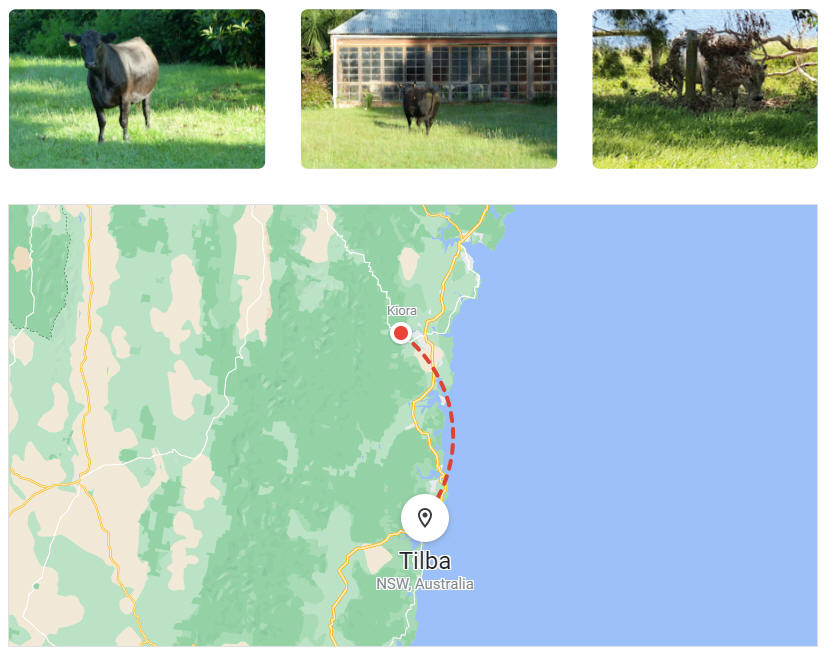
Kiora to Tilba for lunch - about 70km - less than an hour's drive

There's Central Tilba and Tilba Tilba. Both are historic villages but the tourist action is at Central Tilba, in part due to the Tilba Cheese Factory. The village also features several cafés and a number of hand-craft and bric-a-brac stores (need a stock whip?).
The Devonshire tea was good too.
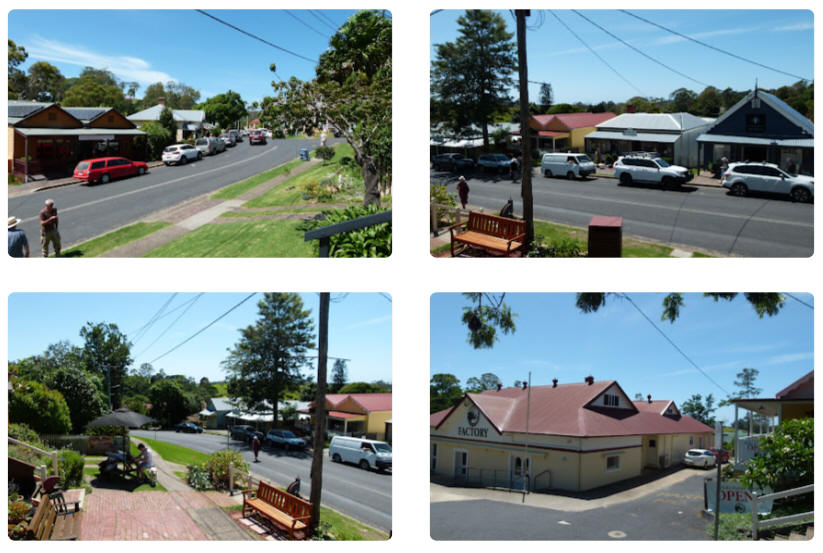
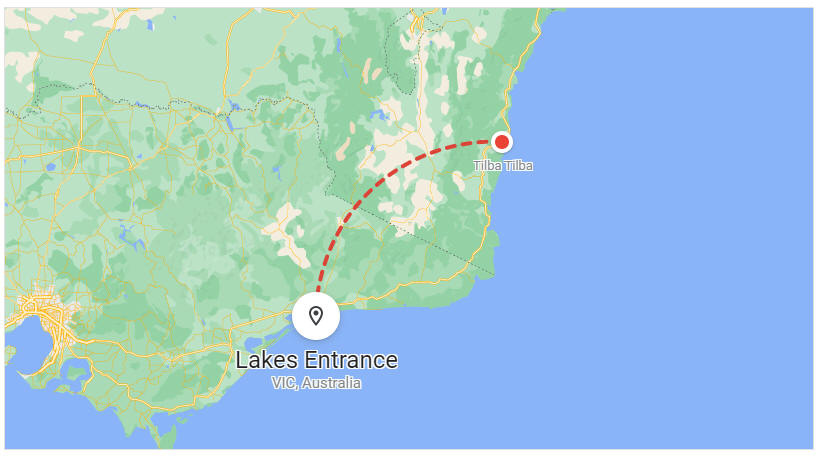
Tilba to Lakes Entrance (our overnight stop). It's - 450 km. This took about four hours of extremely boring driving - as a great part was forest, some of it recovering from the 2020 fires. Mostly, we just zoomed along on cruise control (on the speed limit plus a little bit). Asking Google anything about it was pointless, as there was no mobile connection for much of the drive.
As we have no snaps, Lakes Entrance was either too exciting or too boring to photograph - take your pick.
The Travel Victoria website errs on the latter explanation (https://www.travelvictoria.com.au/lakesentrance/) - but it wasn't that bad.
We had a nice long walk, along the front, and bought takeaway dinners to eat later, watching TV.
The Sandbar Motel was very comfortable with good: bed; linen; shower and WiFi (the essentials) - and even had Netflix
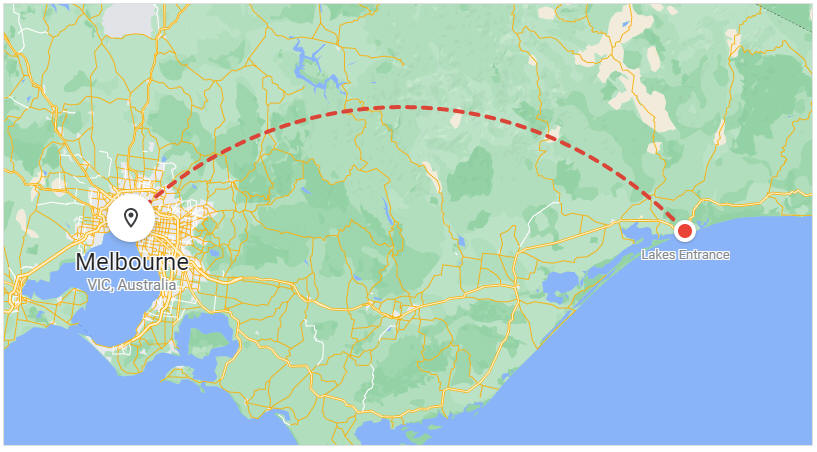
According to Google Maps, Lakes Entrance to our destination in Melbourne is 320 km.
It took us about five hours of (more interesting) diving with stops for lunch petrol and so on.

We'd purchased a four day 'Luxury Escape' to the Crown Metropol Melbourne
Our room was on the 21st floor - about as high as the apartment I once lived in in New York. That had an open balcony, so the drop was familiar - except when I stumbled against the window here.

We walked into town then back along the muddy Yarra

The next day we walked to the Queen Victoria Markets - Melbourne's pride then back via the river again.
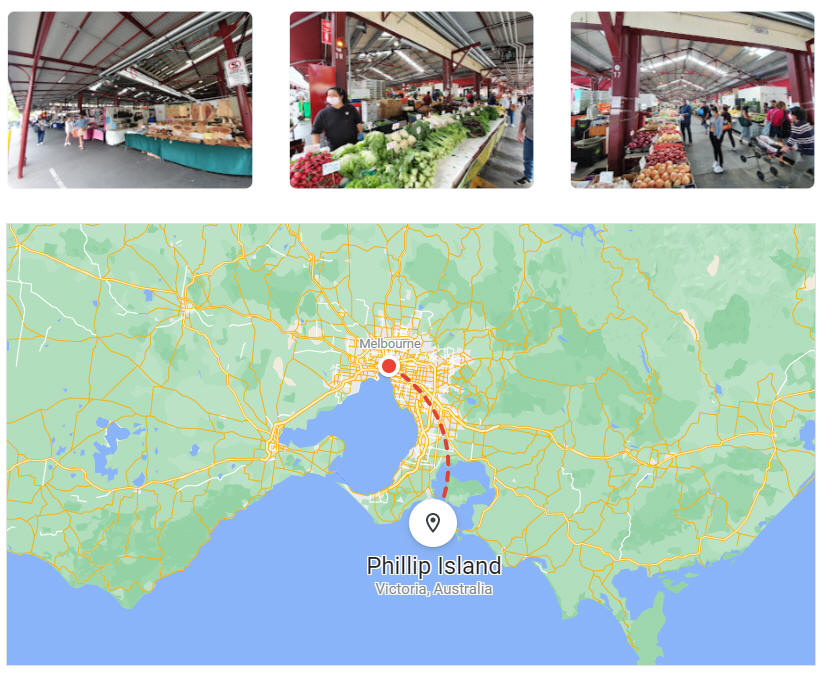
On our third day we drove to Phillip Island.
Phillip Island is 140 km from Melbourne and it should take two hours there and back but there was a boat trailer that had lost a wheel on the way there causing traffic chaos and there is a single bridge to the mainland that involved long traffic delays on the way back. So it was more like three hours each way.
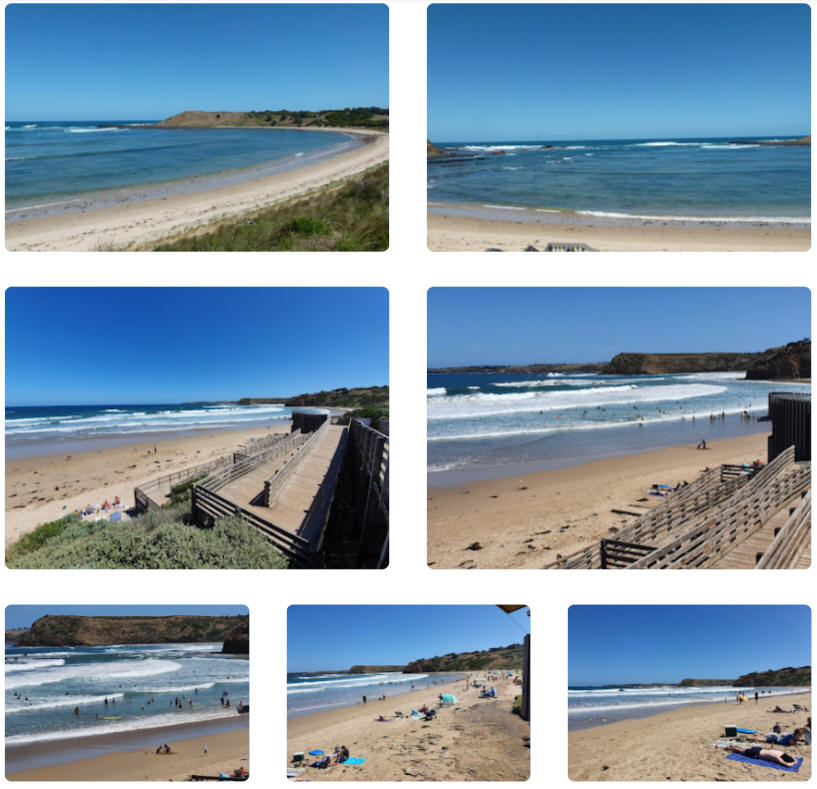
First stop - obvious after a long drive - the facilities at the surf beach (Smiths). And a coffee shop for lunch.
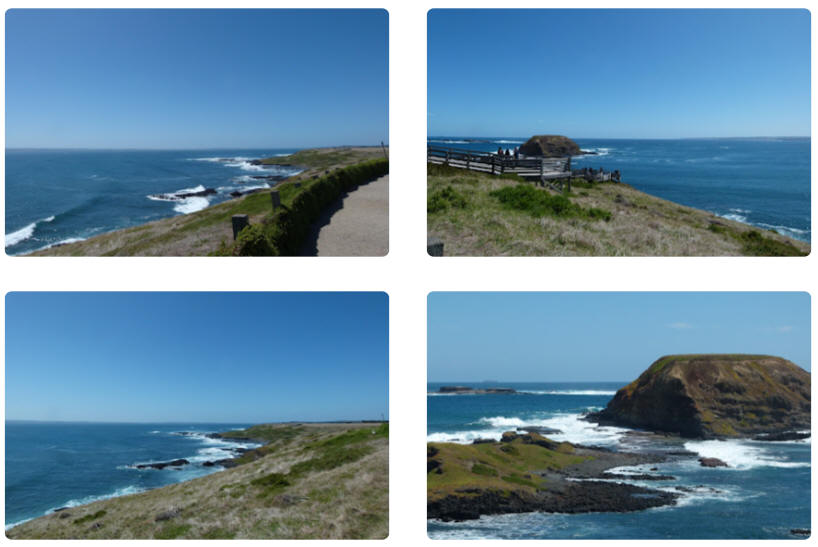
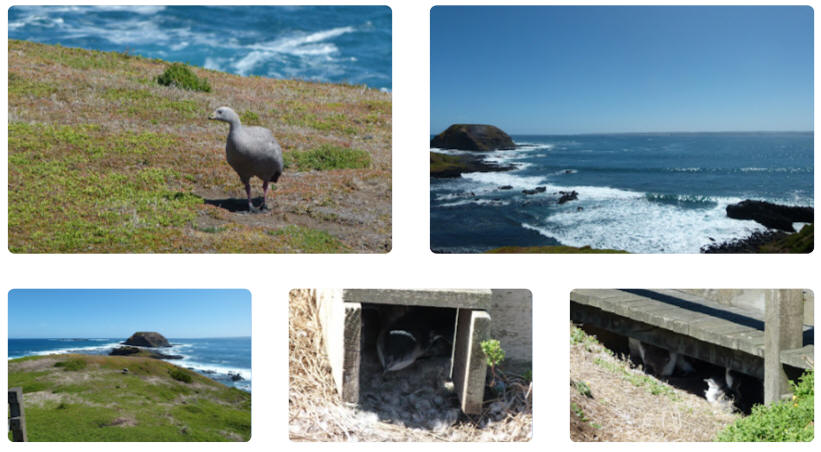
Phillip Island is famous for its penguin colony - seen here lurking - they come out at dusk
Despite the traffic problems, it was a good day out and we enjoyed it.
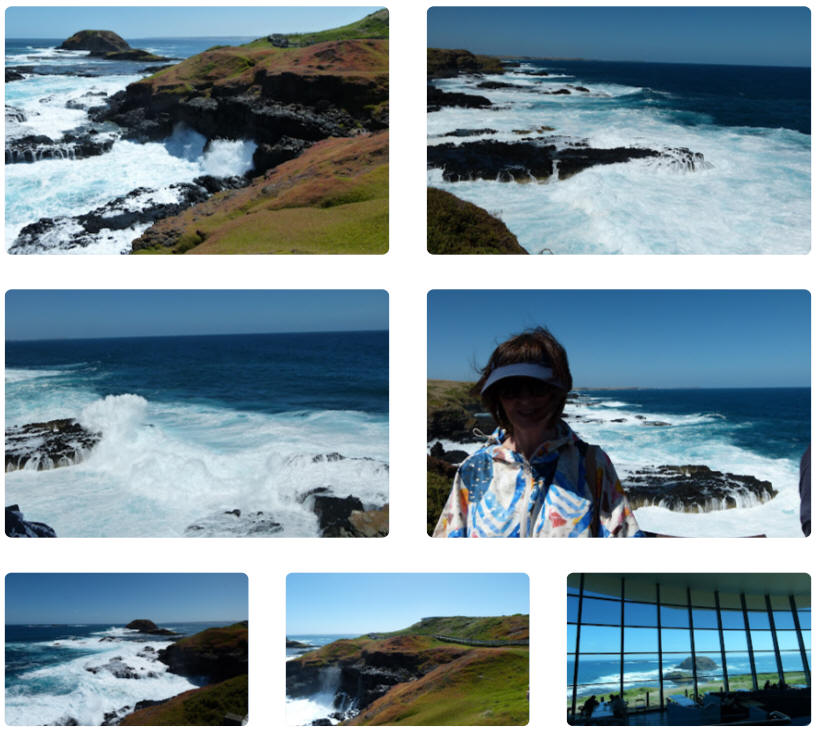
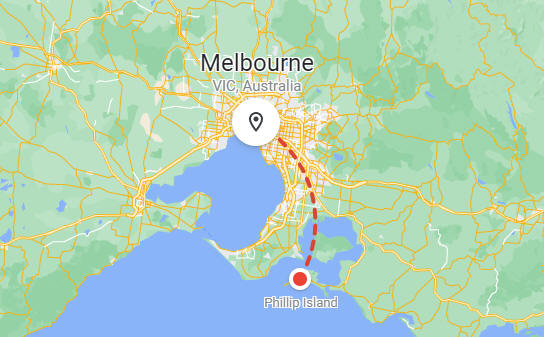
Melbourne hosts, historically, the finest art collection in Australia. The National collection in Canberra may now out-value it but I always enjoy visiting the two galleries in Melbourne (Australian and International art). The Art Gallery of New South Wales probably ranks next yet the Queensland collection in Brisbane see here... is also very good.
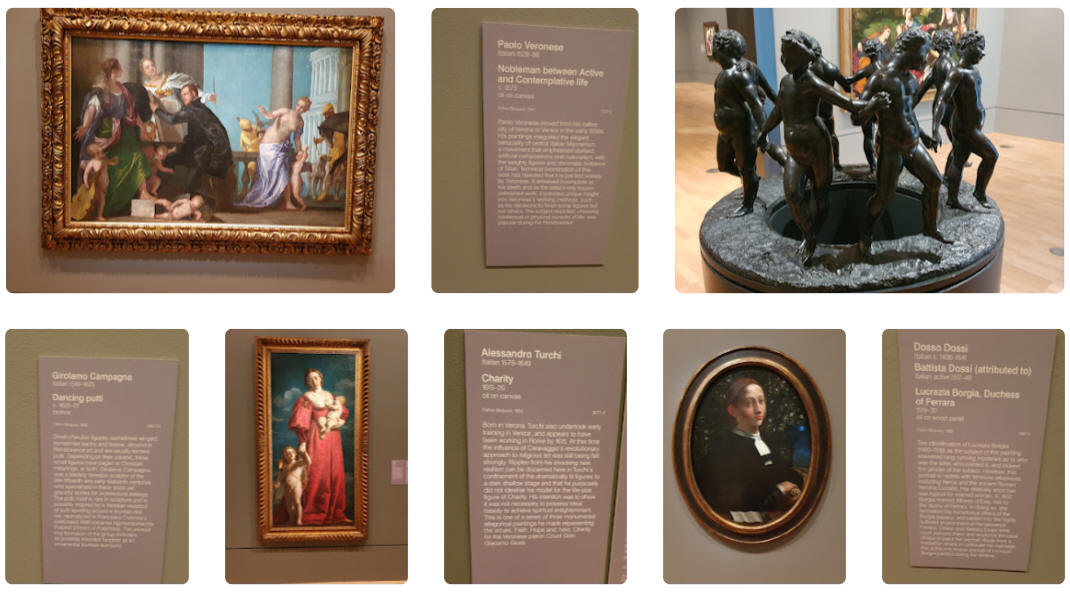
Obviously, this is but a small sample.
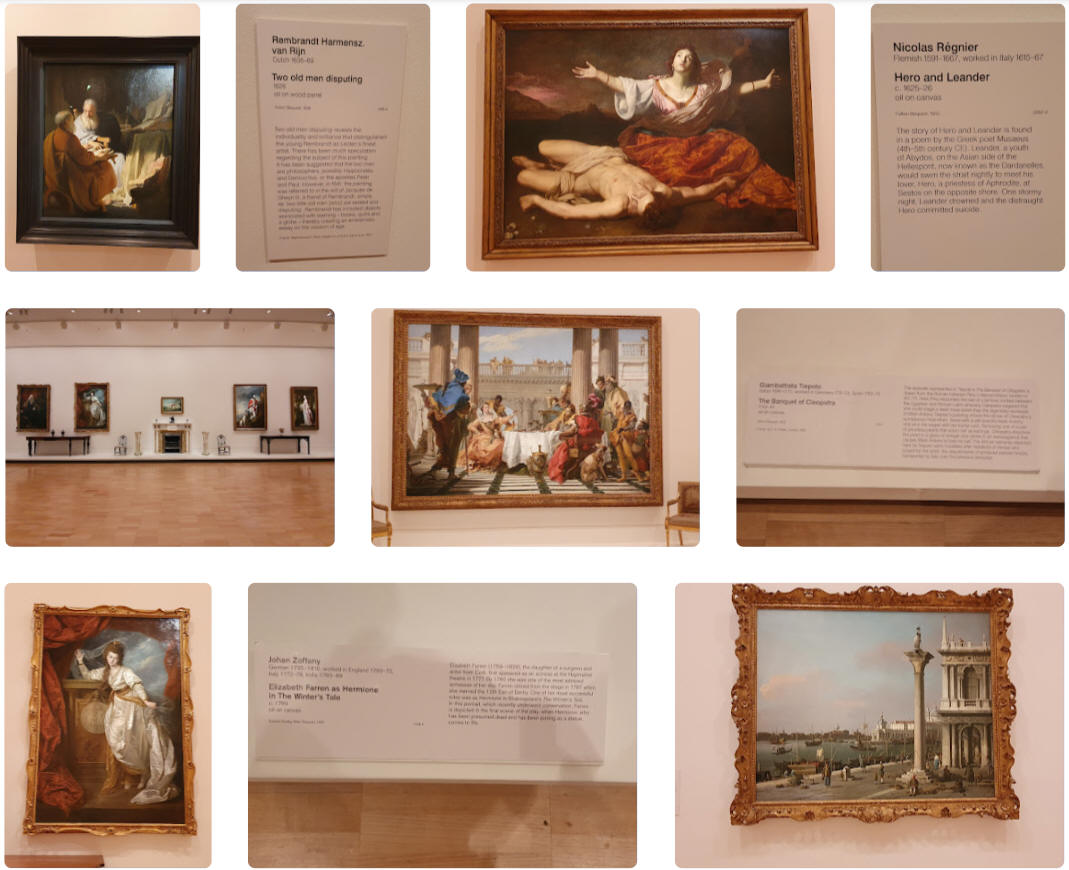
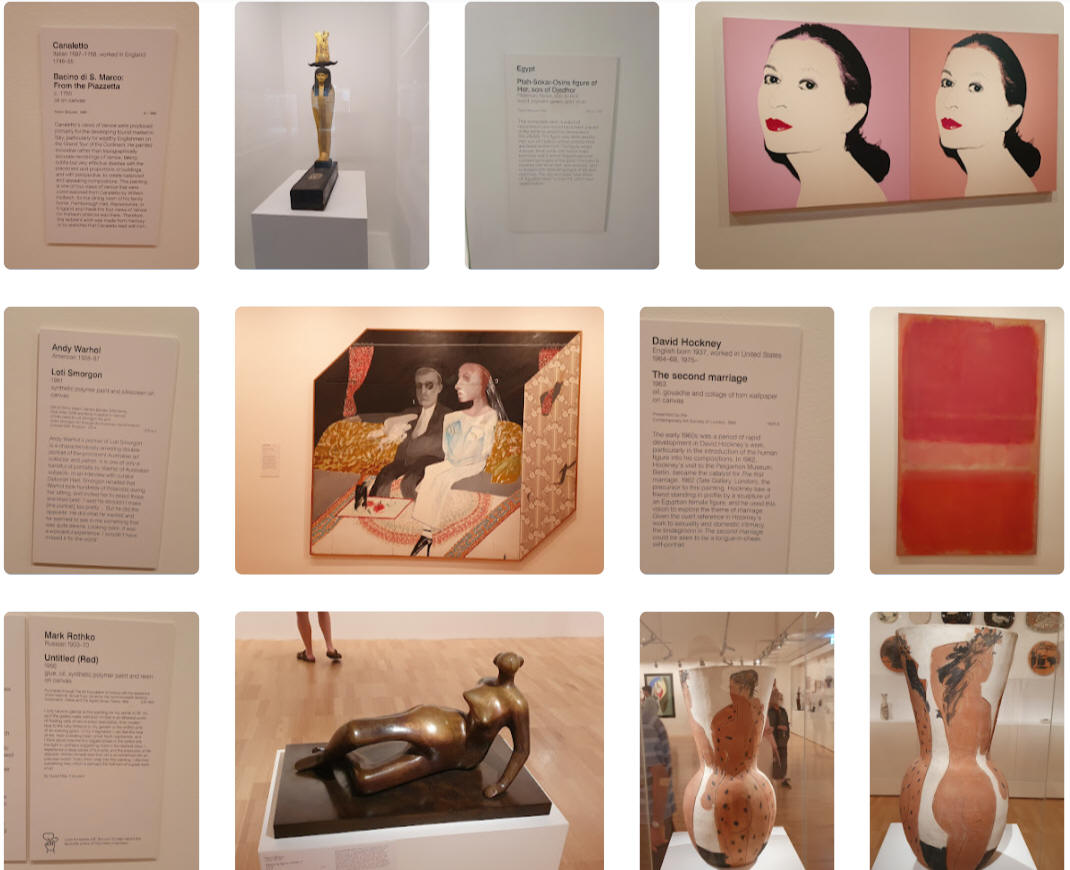
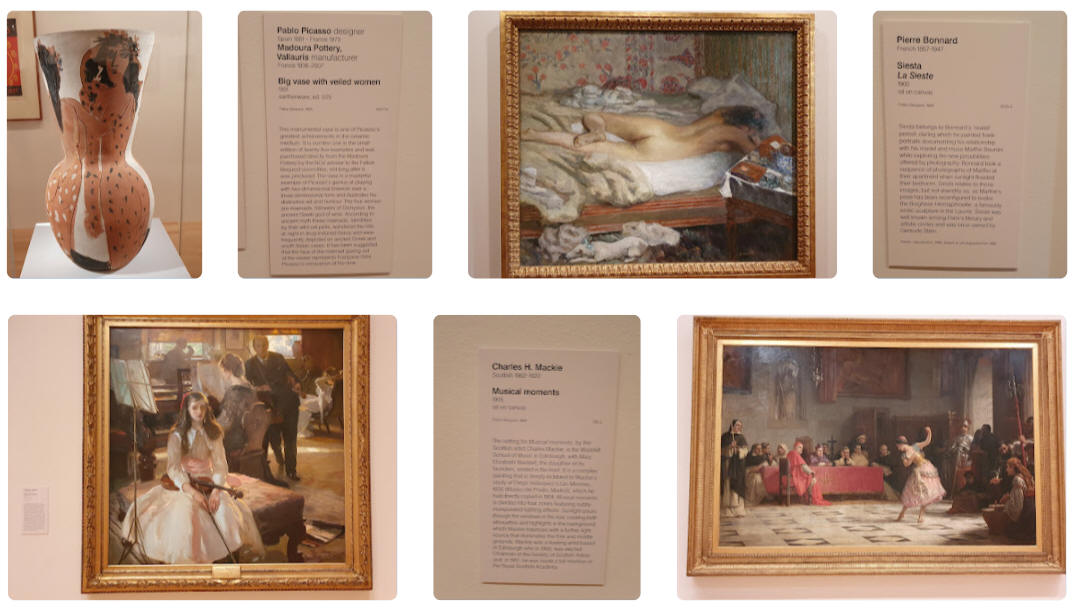
A Pre-Raphaelite influence - once enormously popular in Australia - particularly in the NSW collection.

Australian Art - well sort of. I include the Glover because it illustrates how badly early artists with an English perception represented Australia. The rainbow is appalling - one would have thought that at least that was familiar.
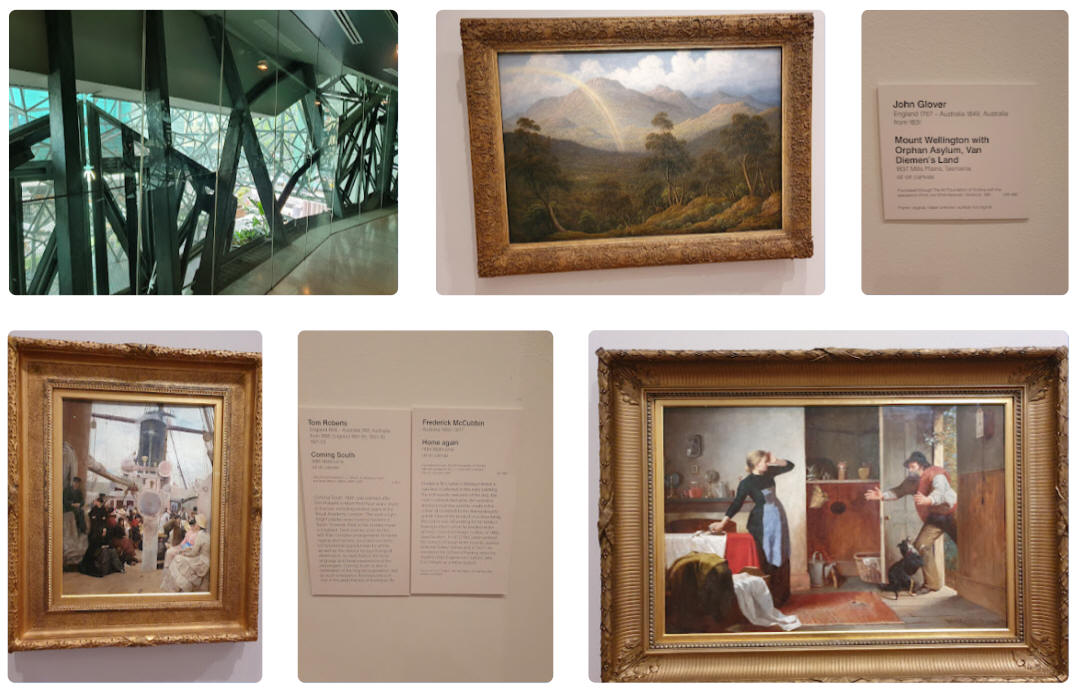

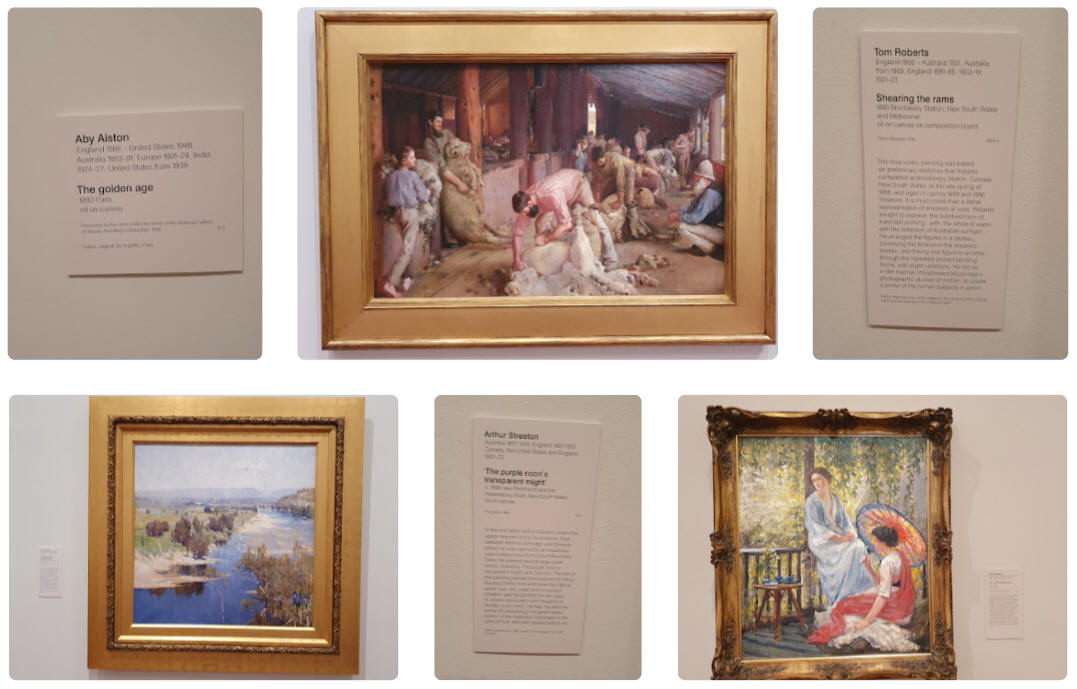
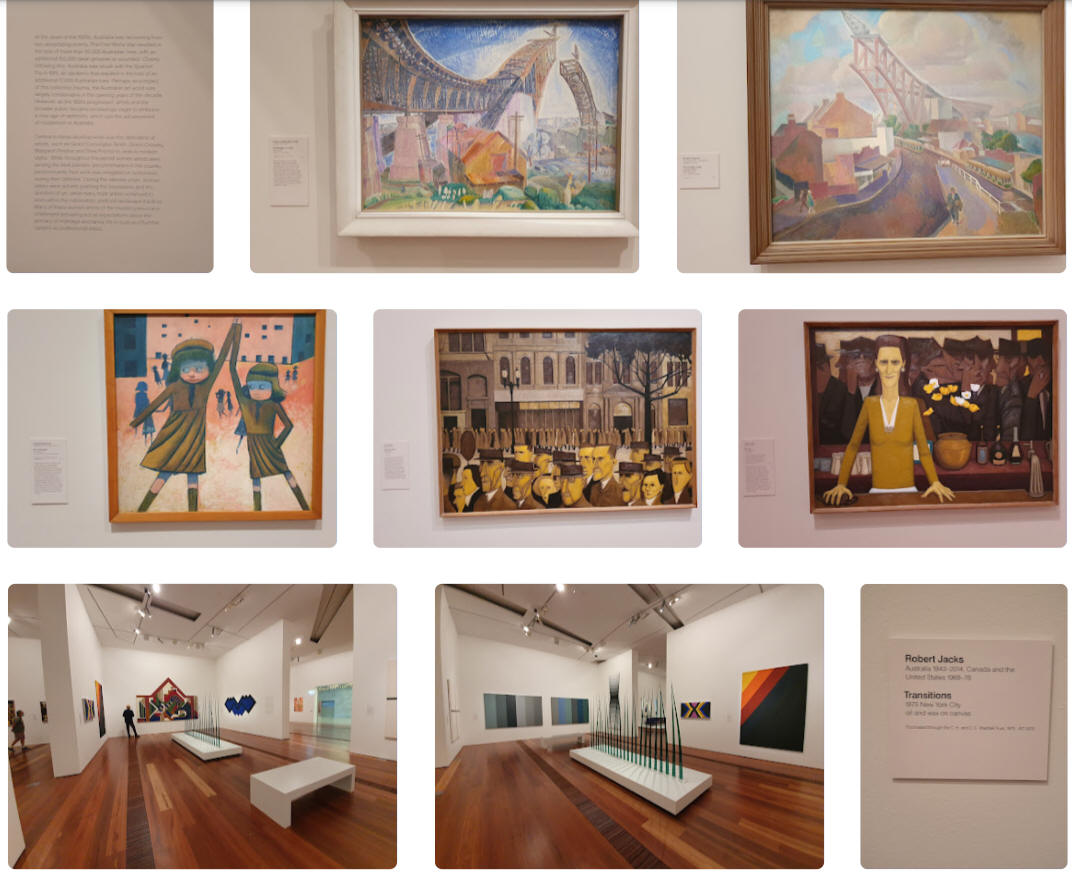
The blue-grey paintings at the end of the gallery were made by Robert Jacks whom I knew when living in New York in the 70's
and later when we'd both returned to Sydney. He died young in 2014.
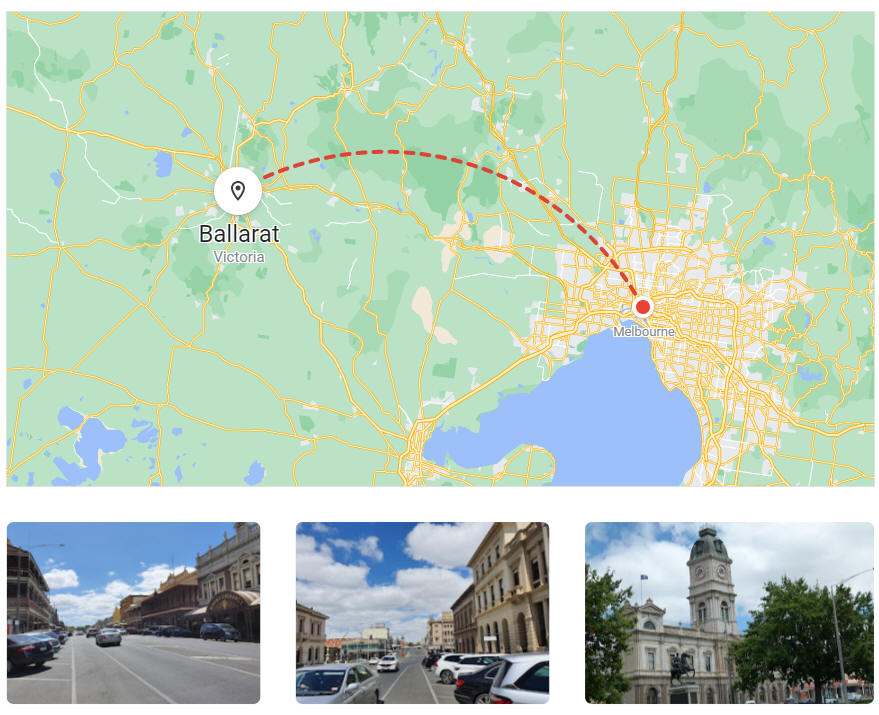
Ballarat is 120 km from Melbourne - under two hours unless there is a lot of traffic or roadwork - a good distance for lunch after a late check-out.
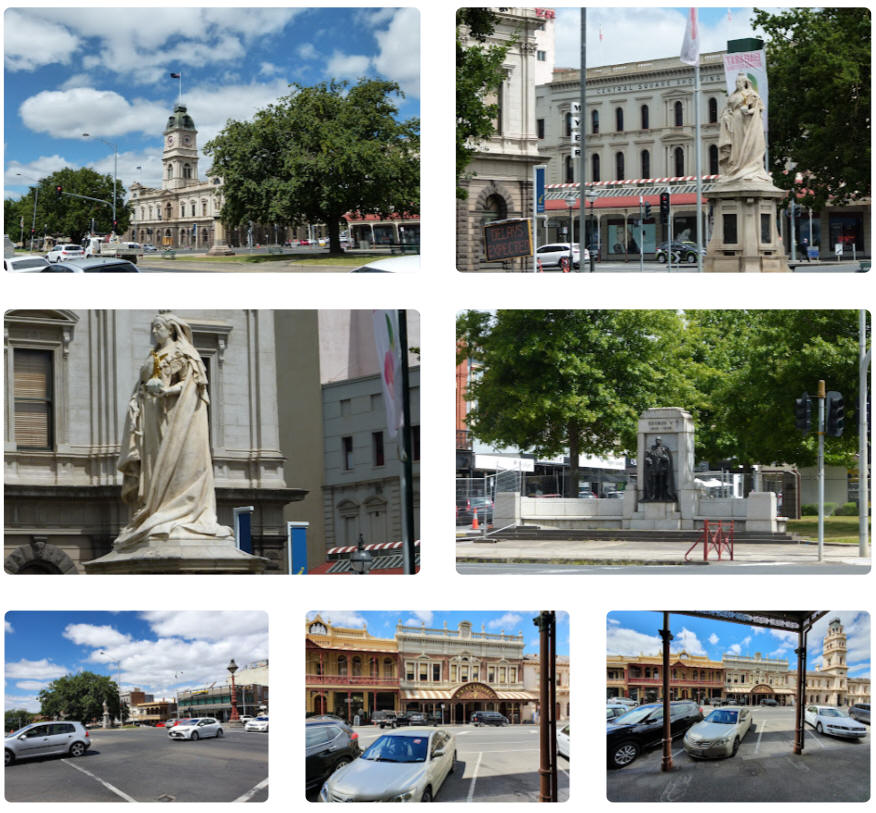
Ballarat is the third largest city in Victoria (pop 157,500). It's a town founded on the Victorian Gold Rush.
There's evidence that gold was first discovered in the early years of the British colony in New South Wales but that the knowledge was suppressed, as not being conducive to good order in a penal colony. But the California gold rush (1848-9) changed all that. Settlers started leaving for California. So, a reward was offered for an Australian Gold discovery and less than two years later it was claimed by Edward Hargraves, for a discovery near Orange in NSW.
Suddenly gold was being found all over the place. Often in creeks and rivers and much of it in Victoria where, in the 1850's, gold nuggets began to be found, some lying on the surface.
In 1858 Cornish miners unearthed a huge nugget weighing 68.2kg at Ballarat. Then in 1869 the largest nugget ever recorded anywhere in the world, the Welcome Stranger (72kg), was found 100 kilometres north of the town. Ballarat was suddenly one of the wealthiest places on the planet.
Law and order had already become an issue at Ballarat, resulting in Australia's second serious uprising against British authority: the Eureka Stockade (1854). And now some old professions would become more profitable: Bushranging and personal services. Indeed, commerce of all kinds.
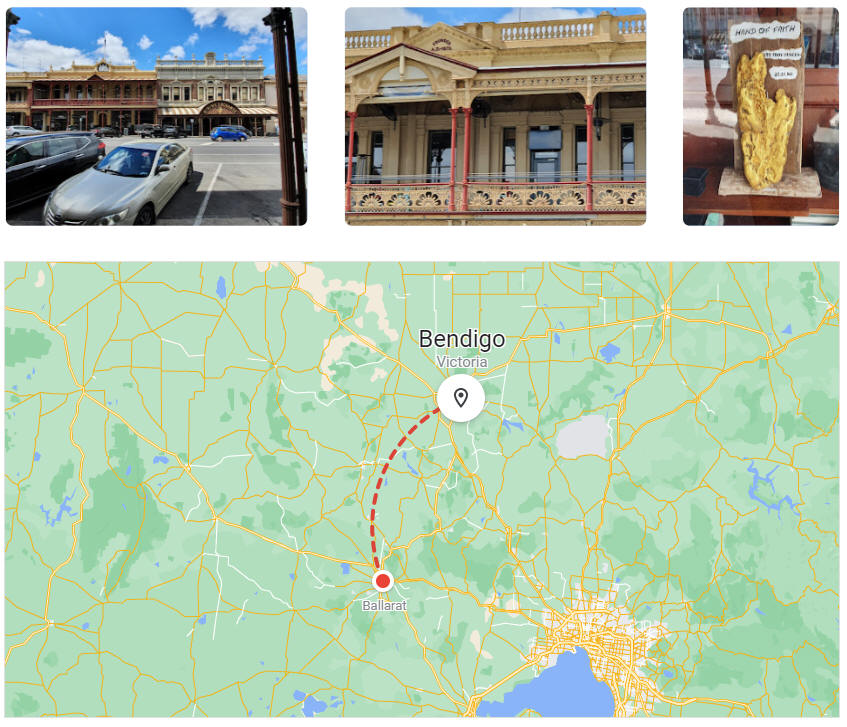
After lunch in Ballarat we set out for Bendigo where we would spend the night.
Another 120 km or so - under two hours driving.
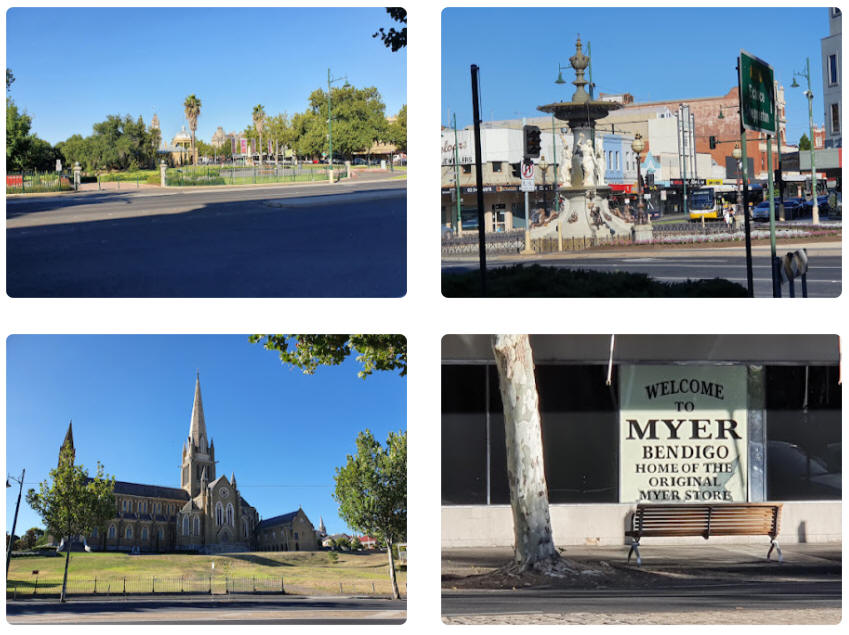
Not to be outdone by Ballarat, and today just a fraction smaller (by population), the area around Bendigo was also rich in gold. As early as 1853 a huge tent city had sprung up here. Yet, save for a few examples, and a matching statue of Queen Victoria (in this case proclaiming her: 'Queen of Earthly Queens') the city lacks Ballarat's iconic Victorian architecture (charm?).
Yet, there are a few examples. Across the road, from the Queen of Earthly Queens, is an historic pub: the Hotel Shamrock, where we had dinner.
I later discovered that the Shamrock (Guinness on tap) dates back to 1854 and once, like all good frontier towns, encompassed a music hall. As the town's wealth increased the hotel prospered and was completely rebuilt in iconic colonial style in 1897. But by the 1970's it was rundown and due for the wrecker's ball. The historic building was saved from impending demolition, as a building of state heritage significance , by the Victorian Government and was leased to a commercial management company (the Comfort Inn chain). In the interests of commercial success, the large rooms were up-graded with en-suite facilities and the historic public areas were fully restored. It was officially reopened by Prince Charles and his initial bride, Diana, Princess of Wales, during their royal visit in 1983. No doubt the statue of great great great grandma across the road was a comfort to him? Perhaps her presence there, so far from home, contributed to their, much vaunted, connubial bliss?
Our table, at dinner, was adjacent to a large table of classic car enthusiasts, of a similar age to us, who had driven up from Adelaide and who determined to keep us amused.
By 1910, around 1200 nuggets (each in excess of 620g) had been found in Victoria and for a time the State surpassed New South Wales in population. This is still evident in Melbourne's architecture from the period.
Gold's initial easily accessible abundance in Australia was in part due to it having no value, until the arrival of the first Europeans in 1788. So people had not actively sought it out nor collected it.
Unlike people in Europe, Asia, Africa and the Americas, indigenous Australians had little use for gold. It's heavy and too soft for tools and they had no means of smelting it or working it.
Smelting gold requires ceramics (and kiln technology), that had not yet been developed in Australia.
Today most Australian gold (sill a significant export) is mined on an industrial scale. It's now been found in every State.
At last tally, Western Australia's share of annual production was 67% followed by New South Wales with 12% and Queensland with 6%.
Victoria's commercially viable gold is largely mined out. But you never know, there may still be some big nuggets, lurking, just below the the range of the fossickers' metal detectors.
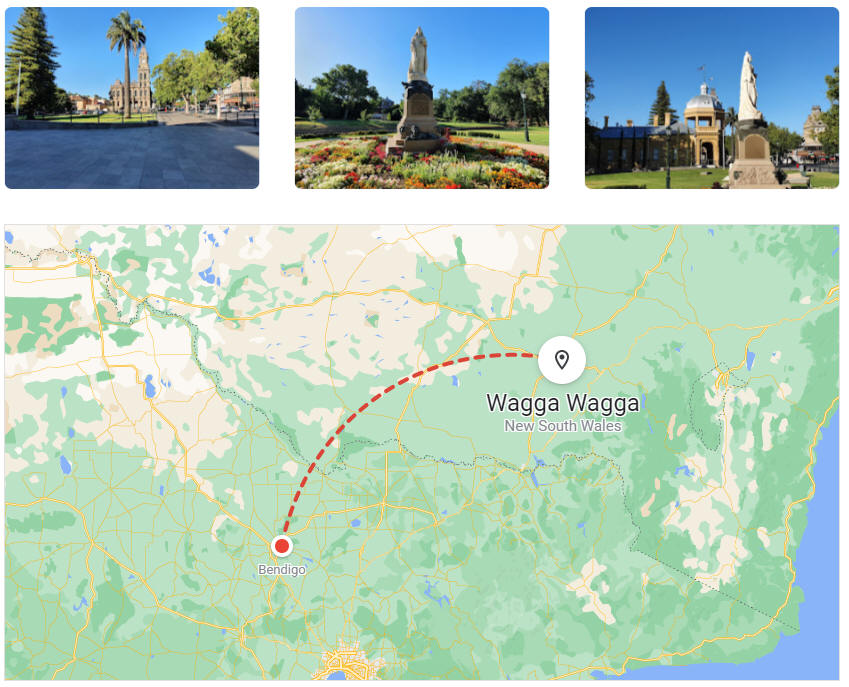
It's about 900 km from Bendigo to our home in Mosman so we decided to break our journey about half way, at Wagga Wagga, on the Murrumbidgee River
Wagga Wagga is about five hours drive from home non-stop. So in the past I've flown here. But we had all day.
It's in New South Wales and a regional services city, with considerably smaller population than either Ballarat or Bendigo. As the locals say "it's so good they had to name it twice". Yet, repeat naming is quite common in Australia (eg Woy Woy and Tilba Tilba) where Aboriginal names are frequently applied (and preferred).
I like Wagga, it has a familiar country charm and we enjoyed the evening in a local pub, appropriately: The Victoria.
Our motel was comfortable too.
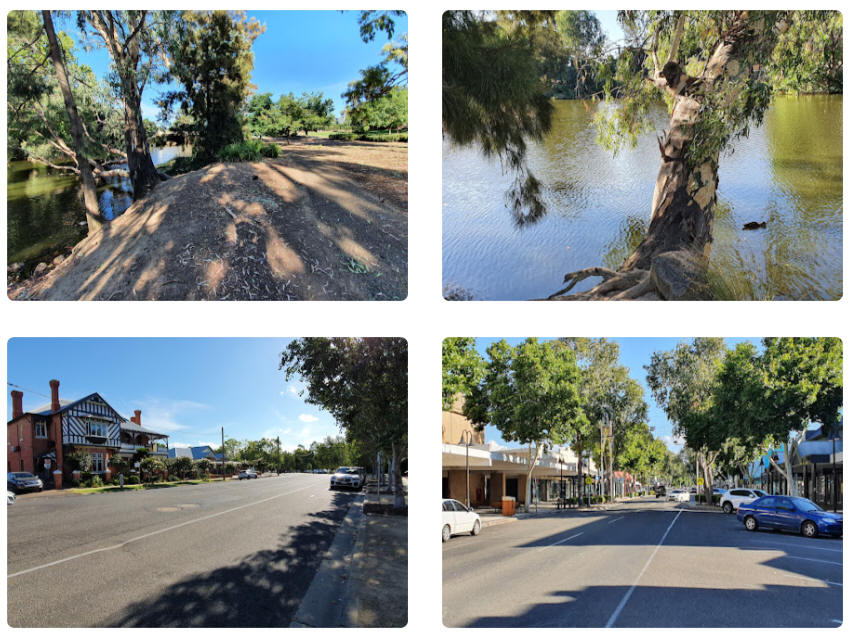
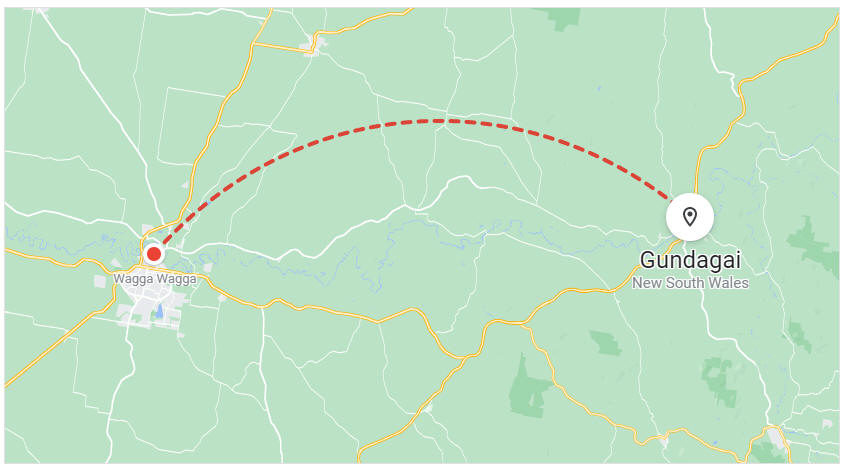
We broke our journey home with a stop for morning coffee in Gundagai - just an hour down the road from Wagga.
As we were on the road home it seemed appropriate.
'Along the Road to Gundagai' is one of the few original Australian folk songs - as opposed to adaptations of Irish or English tunes.
All together now (Australians only):
There's a track winding back...
For those who are Australian but too young (old accent )
| No responsibility is accepted for linked third party video or media content - see Terms of Use and Copyright. |
Or (Slim Dusty, AO MBE etc - modernish accent)
| No responsibility is accepted for linked third party video or media content - see Terms of Use and Copyright. |
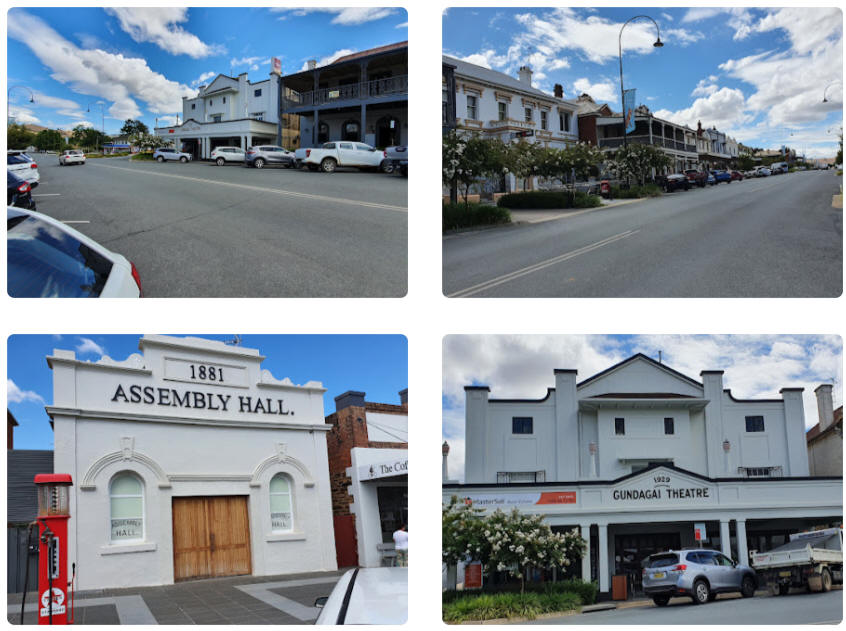
Further on, we would stop for fuel and something to eat for lunch, near the Big Marino in Goulburn
For most of the trip we'd enjoyed blue skies.
Now, the wipers began to swish furiously, as we approached rain-sodden Sydney.
The garden didn't need watering.
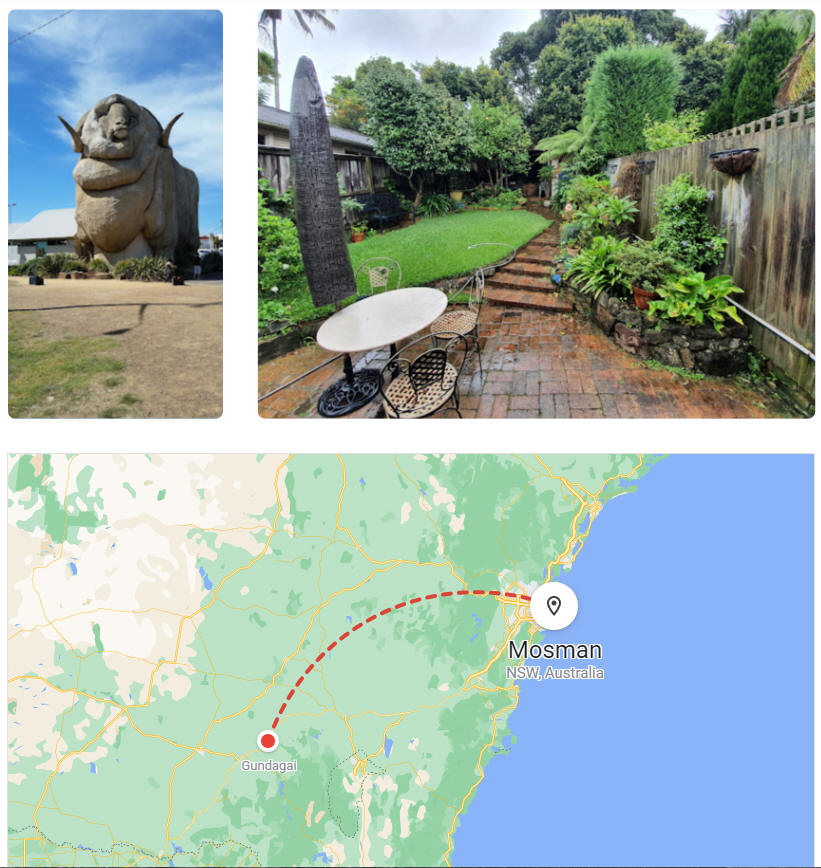

Recently the National Electricity Market in Eastern Australia had to be temporally suspended due to a short-fall in generation.
Now, the new Federal Government, that came to power on a promise to substantially cut power bills, has had to concede, that instead, there will be substantial price increases.
In part, they are blaming the war in the Ukraine; the consequent sanctions against Russia; and Russian retaliation.
During the election campaign the Shadow Minister for Climate Change and Energy repeatedly asserted that the solution lay in increased wind and solar generated electricity, that he also repeatedly asserted were cheaper than fossil-fuel generated electricity.
Yet, now the solution is said to lie in 'temporary' price caps on the spot-price of steaming coal and gas (mainly methane).
An observer from another planet might ask: why the global demand for steaming coal and gas is still rising (and with it their price) when wind and solar are, allegedly, so much cheaper?
Meanwhile, last July (2022) Wendy and I had occasion to visit the town of Rønne on the small Danish island of Bornholm. There on the quayside were a dozen huge wind-turbine nacelles.
As I had some spare time on my hands, I looked on-line and discovered that they were Vestas V174-9.5 MW units for installation off the coast of Germany, for either the Baltic Eagle or Arcadis Ost 1 project. I compared the published project costs with those of other large scale energy projects around the world.
You can read my analysis here (Europe 2022 - Part 1 - An Energetic Diversion).
Suffice it to say, that wind-generated electricity is not price-competitive with modern fossil generated electricity - it's just a lot cleaner.
Most importantly: nor is off-shore wind anywhere near price-competitive with the latest nuclear generated electricity (on a dollar per unit of installed capacity basis), as nuclear power has a similar cost per Watt of capacity but doesn't require additional batteries or pump-storage to satisfy fluctuating demand.
The present situation on the east coast of Australia may (or may not) have been aggravated by the war in the Ukraine. Yet, the short-fall was entirely predictable, over a decade ago, and it will not go away when the war ends.
In anticipation, back in 2012, I called for a 'root and branch' reappraisal of the combined impact of the Renewable Energy Target scheme, in the context of the operations of the National Electricity Market (NEM):
2012"The present government interventions in electricity markets, intended to move the industry from coal to renewable energy sources, are responsible for most of the rapidly rising cost of electricity in Australia. These interventions have introduced unanticipated distortions and inefficiencies in the way that electricity is delivered. Industry experts point to looming problems in supply and even higher price increases. A 'root and branch' review of these mechanisms is urgently required to prevent ever increasing prices and to prevent further potentially crippling distortions." Read more: Electricity Pricing |
I asserted that together these were making essential base load generators unprofitable and may lead to brownouts and blackouts in the future:
2012"Now, in addition, rooftop photo-voltaic (PV) solar is beginning to add power to local distribution grids in mid-summer, when the market price is at its maximum and thermal stations have previously been assured of a profit. Again the retailer pays for STC’s that subsidise the price of solar. While again we might applaud the lowering of the peak market price and the reduction of peak grid currents at this time, we will not be so pleased if failure to invest in new generation capacity results in even higher prices; and future brownouts and blackouts. While at first sight there appears to be a well established competitive generation market, the renewable energy targets and the associated certificates (paid for by our retailer and appearing in our bill) may be having an increasingly adverse effect on future investment decisions; with potentially disastrous outcomes ‘down the track’." |
The article was written at a time when an ill-conceived Carbon Tax, that only targeted particular industries and in some cases individual businesses, was severely distorting the energy marketplace even further.
A year earlier I had objected to the Gillard Government's short lived Carbon Tax on these grounds:
2011"Well, the Gillard government has done it; they have announced the long awaited price on carbon... Accusations of lying and broken promises aside, the problem of using a tax rather than the earlier proposed cap-and-trade mechanism is devising a means by which the revenue raised will be returned to stimulate investment in new non-carbon based energy. Taxation always boils down to 'robbing Peter to pay Paul'. In this case the Government knows who Peter is but they apparently have no idea, or too many, about Paul. Read more: Australia's carbon tax |
The Carbon Tax has gone but not the underlying problem remains: traditional coal fired power stations - upon which we will still need to rely for at least another decade - cannot remain viable as long as they are continually gazumped in the NEM by cross- subsidised renewable electricity generators.
This cross-subsidy, is in the form of Large-scale Generation Certificates (LGC's), paid for by electricity retailers (in other words: you). Each MWh of renewable energy supplied receives this cross-subsidy (effectively at the expense of other generators). It applies irrespective of the rapidly fluctuating (NEM) market price for that electricity (energy), that from time-to-time is very low or negative, due to ample wind or sunlight and low consumer demand.
By this means, renewable electricity, including rooftop solar, has been given a 'leg-up', in order to meet the Australian Government's Renewable Energy Targets.
When governments intervene in markets it always has consequences. Such an intervention maybe necessary in the long-term public interest, for example due to externalities, like the environment, or international responsibilities. Yet, then it is beholden on Government to put in place accompanying means of mitigating the inevitable negative consequences.
In this case the negative consequences of Renewable Energy Targets on base-load electricity generation have been well known for well over a decade but nothing has been done in mitigation.
Possible mitigations might include:
- an off-market base-load generation reservation and/or, perhaps;
- ineligibility of all Renewable Energy Certificates (small and large scale) for energy supplied when supply exceeds demand.
Comprehensive modelling of these and other possible interventions, such as a targeted subsidy, is now essential to determine the best transition path to a secure electricity future.
A 'root and branch' review is long over-due.
___
If only...'If onlys' are a bit pointless, yet I'll say it again: Had we embarked on building just three nuclear power-stations similar to the Cruas Nuclear Power Station in France, two or three decades ago (read more...), we could already be 'clean and green' and not in the predicament we now find ourselves in today. Instead, we find ourselves paying for Snowy 2.0 that will be: more expensive; more environmentally damaging; and totally inadequate to make a significant difference (see: Pumped-Storage Hydropower (PSH). Read more.... But that's all water over the dam now. |
The latest edition of the ABC's Science Show reported as news that chimps can do some tasks better than can humans.
A 5 1/2-year-old chimpanzee named Ayumu performs a memory test with randomly-placed consecutive Arabic numerals,
which are later masked, accurately duplicating the lineup on a touch screen computer.
Chimps could memorise the nine numerals much faster and more accurately than human adults.
We are quite used to being inferior in the world of physical feats or endurance. A dog can smell and hear things we can't. Many animals run or swim better; and some can fly without mechanical assistance. But we like to think that we have higher intellect that all other animals; whatever intellect means.
I have a guilty secret. I like action novels.
As a child I liked the Famous Five and Secret Seven books of Enid Blyton and when I was a schoolboy I enjoyed the novels of Conan Doyle (the Sherlock Holmes books) that are as much about action as they are about crime detection. I read Forester's Hornblower series and subsequently, as an adult, all of Patrick O'Brian's seafaring novels. As a student I read Ian Fleming's James Bond books as well as a lot of Science Fiction with an action element; Asimov and so on. There have been many others in the 'action/spy/thriller' genre; Raymond Chandler of course.
So when the Bourne movies appeared I began reading the Robert Ludlum novels, upon which they are very loosely based.
Ludlum died in 2001 in Florida in a 'mysterious fire'. Five years after his death the The Bancroft Strategy appeared. This is the last book credited entirely to Ludlum before several other writers were openly contracted to write under his name. I have now read a number of these too.
So why single out The Bancroft Strategy?

